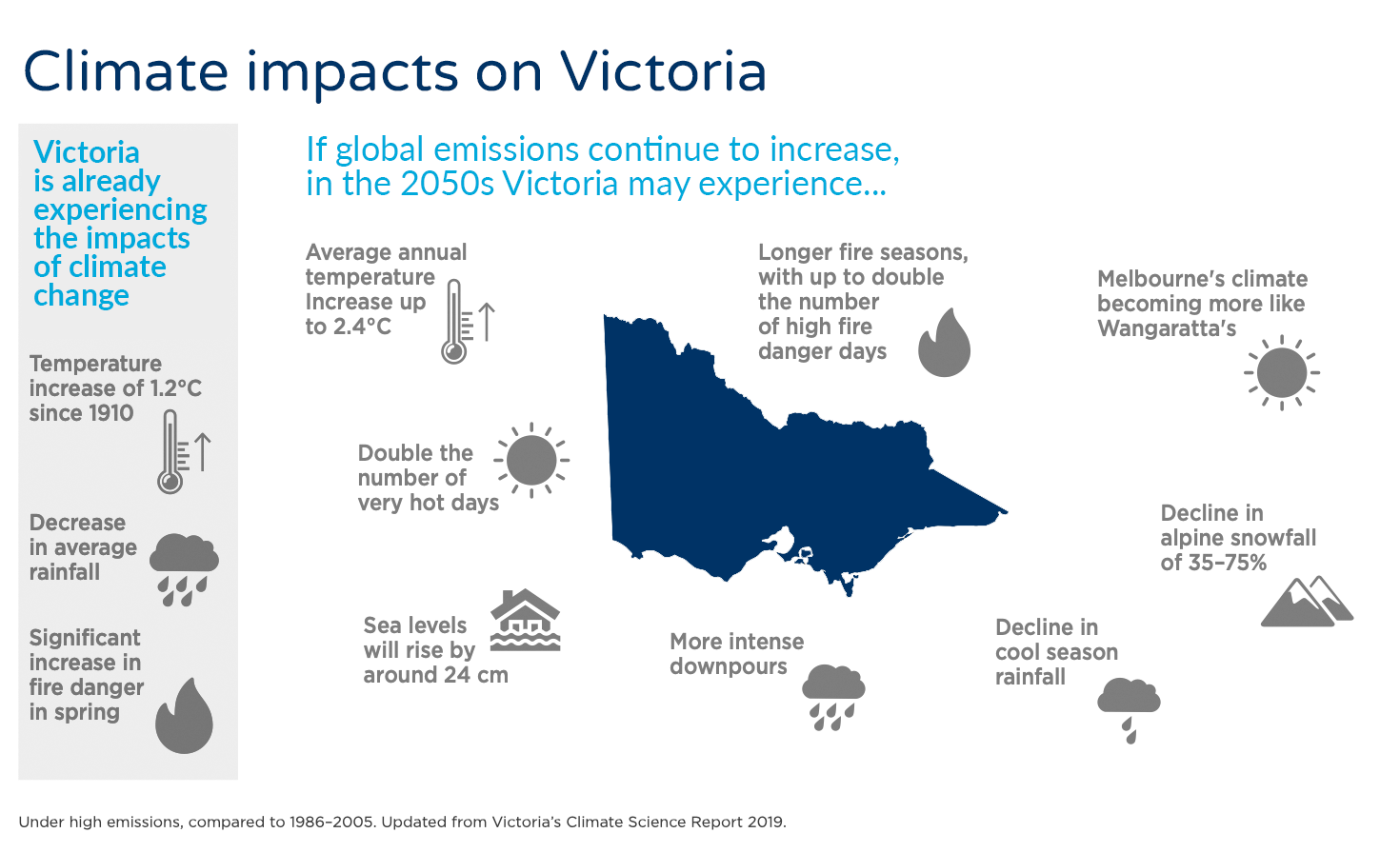Overview
Organisations that consider climate change in their decision-making will be better prepared to respond to its impacts and the community they serve. By confidently acting on the foreseeable risks, you’ll set your business priorities and allocate resources to ensure you:
- continue to deliver on your organisation’s role and purpose as the climate changes, contributing to a more resilient Victoria
- contribute to reducing greenhouse gas emissions.
Dedicate time to consider climate change and be prepared to act
Our climate is changing but there’s uncertainty about the nature, timing and velocity of specific events and how these will impact us as individuals, organisations and communities. Spending time to consider how climate change may impact our activities, functions and strategies is putting risk management into practice. This way of thinking applies to decisions you make at home as well as at work. For example, being conscious of climate change will affect decisions about where you live or how you consume energy.
To find out more about managing the risks presented by climate change, please refer to our topic Using risk management to help you address climate change.
What are climate change risks?
Risks occur when a possible event arises that disrupts your ability to meet your objectives. Climate change can present new risks or multiply the risks you’re already aware of. It challenges your assumptions about your organisation’s resilience and capability to deliver on its role and purpose. The nature of this risk might differ from risks you’re familiar with because it needs in-depth assessment, has a longer timeframe and is highly uncertain.
Climate change risks include physical risks, transition risks and the liabilities that flow from each of these. These can have flow-on financial impacts, across your revenues, expenditures, assets, debts, capital and financing. They can impact your service availability, reputation and trust. Your organisation and its directors could be exposed to litigation for failure to act.
We’ve based our guide on content published by the Task Force on Climate-related Financial Disclosures. Visit Task Force on Climate-related Financial Disclosures(opens in a new window) to find out more.
A snapshot of how the Victorian Government is approaching climate-related risks can be found on the Climate-related Risk Disclosure Statement(opens in a new window).
Physical risks
Physical risks arise from changes in the frequency and severity of extreme weather events, long-term changes in weather patterns and rise in sea levels. They include:
- Acute risks which are event-driven, including increased severity of extreme weather events, such as cyclones, hurricanes, or floods.
- Chronic risks which are longer-term shifts in climate patterns (e.g. sustained higher temperatures) that will cause sea level rise or chronic heat waves.
Physical risks will particularly affect your organisation if you’re already exposed to the climate and have, for example:
- long-lived, fixed assets
- operations in climate-sensitive regions (e.g. coastal or flood zones)
- high reliance on water availability
- dependence on value chains exposed to the above.
Sectors that are more exposed to the physical risks such as agriculture, transportation and building infrastructure, health, insurance and tourism.
Consider a range of time horizons for physical risks
Victoria’s climate has already changed and will continue to change over time. To think about physical risks, consider short-, medium- and long-term time horizons and document these in your risk assessments.
What timeframes you choose for risk assessments depend on your organisation’s objectives, sector and expected lifetime of capital investment structures, assets, leases and infrastructure. These will affect how you assess risk.
| Timeframe | Notes to help you access risk | |
| Short-term | 2-5 years | This timeframe might be considered long-term for some organisations. Typical likelihood scales can be used to assess risk. |
| Medium-term | 5-20 years | Likelihood scales won’t work well to assess risks. Use scenario analysis instead. |
| Long-term | 20+ years | Use scenario analysis to assess risks at 2030 and 2050. Look beyond 2050 out to 100 years if you’re dealing with:
|
See Victoria’s changing climate (climatechange.vic.gov.au).(opens in a new window)
Transition risks
Transition risks arise from social and economic changes associated with adjusting to the low-carbon economy as required by the Victoria’s Climate Change Act 2017. The Act establishes a long-term target of net zero greenhouse gas emissions by 2050. This implies a move away from fossil fuel energy and related physical assets. You can face transition risks through:
Policy
Disruption from policy changes to limit actions contributing to climate change (e.g. introducing policies to reduce greenhouse gas emissions).
Legal
Litigation (e.g. from allegations of a failure to protect citizens from known impacts, reduce climate change impacts, failure to adapt, or adequately disclose climate change risks).
Technology
Disruption from the technological changes that enable a lower-carbon economy (e.g. shifting to electric vehicles and distributed energy systems).
Market forces
Economic disruption from sudden changes in supply and demand (e.g. consumer demands, availability of commodities, products and services and prices.
Reputation
Changes to customer or community perception of your organisation. Your actions, disclosure and changing community standards and expectations affects others’ trust and confidence in you. Expect increasing public and media scrutiny of both your adaptation activities (e.g. planning for more bushfires) and your contribution to the transition to a low-carbon economy (especially your high-carbon activities).
Transition risk will affect most economic sectors and industries. Its clearest impact is on agencies, whose function relates to fossil fuel-based industries, energy-intensive activities and transportation.
Transition risks are more likely to materialise in the short and medium-term but consider the long-term too.
To assess both physical and transition risks, you’ll need to consider climate policy trends domestically and globally. See Victoria’s latest climate change policies at climatechange.vic.gov.au(opens in a new window).
Updated from Victoria’s Climate Science Report 2019. Department of Energy, Environment and Climate Action (Formerly Department of Environment, Land, Water and Planning, 2019, Victoria’s Climate Science Report 2019. Melbourne Victoria. Available online at: Victorias-Climate-Science-Report-2019.pdf(opens in a new window).
Revisit your assumptions
Climate change is a risk multiplier – it exacerbates or accelerates risks you already face. If you’ve recorded weather-related risks in your risk register without considering climate change, you might’ve underestimated the level of risk and need to reassess.
Focus on climate change to better inform your business decisions
Managing risk is about learning to make good decisions despite uncertainty, rather than removing it. We have a whole topic on making decisions in situations of uncertainty, and we show how considering climate change can help an emergency services organisation make decisions by revisiting the assumptions it’s making.
For more information refer to Making decisions in situations of uncertainty on our website.
Climate change affects whole organisations and communities. You should consider its impacts in the decisions you make about:
- how you’ll operate (objectives and strategy)
- what’ll enable you to operate (activities and functions)
- how you work with others (suppliers, clients and community).
Decisions facing an emergency services organisation
In this example, the focus is mainly on physical risks, but transition risks are also relevant:
Look at how your insurances protect you
Many climate risks come with the possibility of financial loss. It’s reassuring to know these exposures can be minimised though your insurance program but you need to consciously evaluate which of your risks can benefit from insurance protection.
Read more at our guide: Minimising your exposure to insurable risk.
Next steps
- Review your risk register.
- Consider how climate change will affect your existing risks.
- Identify gaps and review assumptions considering Victoria’s climate change(opens in a new window).
- Work with risk owners to plan improvement opportunities for both physical and transition risks.
Updated

